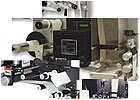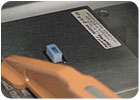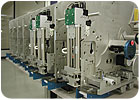Why Most Applicators Don't Work - and What to Do About It

Traditional rollers.
Whether you are an OEM, an ODM or an EMS provider, you probably use labels and film adhesives. Almost all computers, mobile phones, hand-held electronic devices, medical-diagnostics modules and industrial devices use labels and film adhesives. The broad-based acceptance of labeling and film adhesive shows no sign of deteriorating; however, the applicators used to automatically apply these components can be frustrating.
Problem
Following are some common problems manufacturing professionals have with applicators:- Setup is time consuming and complex
- Label or film adhesive does not peel consistently
- Equipment is complex
- Applicator is not accurate or repeatable
- Maintenance is difficult
- Service is poor
- Changeover time from roll to roll is too long
- Lead time is too long
- Design lacks flexibility
- Liner does not track consistently straight
Traditional Methods
The traditional method most label and adhesive-film applicators use employs many outdated industrial solutions. In most cases, these solutions - while attempting to address problems that end users experience - are in fact creating a hidden burden and silently passing along costs in the form of increased downtime, scrap, and additional labor to keep the label equipment operational.Traditional methods include the following.
- Industrial PLCs (for control). PLCs are an established workhorse method to control industrial machinery. There has been surprisingly little evolution in the PLC domain. The simple architecture of single-task, low-level programming language, circular program execution, and no encapsulation of data make the creation of control programs difficult (if not impossible) for today’s complex demands. Parameters that are programmed per application create flexible machines but are not handled well in a PLC environment. Thus, the universality of the applicator is severely hindered. In addition, while simple basic control can be implemented with a PLC, it is difficult to integrate automated procedures, error recovery and visualization functions as an incorporated part of the application.
- Ladder logic. There is nothing inherently wrong with ladder logic. A primary drawback is the programming language’s inability to easily implement programmable parameters. Without full parameter integration, the user-friendliness of the system decreases. As the intelligence of the system decreases, expertise required by the operator increases. Ladder logic works for discrete logic, but math functions don’t fit the language without very complex adaptations. The math functions are the enablers that provide for user-friendly functions that limit required human expertise.
-
Rollers (to advance the liner). The most
common method to advance a liner is with a roller to drive or take up the
material. However, most rollers actually encourage a liner to drift. The materials
of construction for the roller, liner, gear driving the liner, ball bearing and
any other physical component in the system all have tolerances. These
tolerances ultimately mean that the force across the face of the roller will
not be consistent. This is true for the very first cycle of the labeling
equipment; it only gets worse with the inevitable wear and contamination of
industrial machinery usage. Beyond just a tracking issue, adhesive
contamination causes routine maintenance and periodic roller cleaning.
Eventually, the rollers wear out and must be replaced, starting the process
over again. All the while, the operator is tweaking the applicator’s
adjustments in a futile attempt to get the material to track straight.
Rollers also require that rotary motion be translated into linear distances. Various techniques can accomplish this task somewhat effectively, but they cannot account for liner slippage and stretching. Slippage presents a particularly difficult challenge, as the amount of slippage is constantly changing, depending on uncontrolled factors such as release agent buildup, roller durometer changes during component life, contamination, and wear. -
Unitension. Using the take-up roll on
the machine for liner tension determination presents a fundamental problem: it
burdens the operator with constantly changing liner tension at the point of
peeling as the roll shrinks. Thus, an application may run well at the beginning
of the roll but not through the entire roll of parts, leaving the operator to
wonder why and then to begin adjusting the labeling equipment. The operator’s
intuition is correct - something does need to be changed for the roll to run
consistently. However, once the subtle tweaking of the label applicator begins,
it will usually take a trained technician to get the equipment back to a
baseline operational stated.
Applicators also use peel-assist methodologies like air jets or pre-peeling techniques to ensure the part peels. In the end, without the capability to independently control the tension throughout the entire system, these are only attacking the symptoms instead of curing the disease. - Speed. As today’s technologies continue to force subassemblies and components to become smaller, accurate label and film-adhesive placement has become more important. Most applicator technology used today was designed in a different era, in which speed was the driving factor and accuracy was an afterthought. Thinking of accuracy as a byproduct of the design can no longer be deemed acceptable in today’s manufacturing environment.
- Customization. In many instances, custom machines are developed around the specific requirements of a particular assembly job. Although certain custom machines will perform the desired application successfully, many do not, thus throwing into question the viability of applicators. Custom equipment is manufactured on a limited timeline and pushed into production to meet the anticipated launch date and volume requirements of the end product. Manufacturing locations must then ensure that the equipment is kept operational and yields the required volumes, regardless of its actual suitability. Adding to the complexity, manufacturing sites are increasingly located in low-tech regions with limited technical capabilities.

Label stack.
The Evolved System
Having examined the traditional method of approaching adhesive film and label applicator solutions and their inherent problems, let’s take a look at an “evolved system.” This system looks at the holistic view of the process and provides a clear outlook for success. The system includes the following.- A multiprocessor. A multiprocessor allows a system to multi-task and provides the framework for implementation of sophisticated motion control. Data can be continuously collected at extremely high rates from inputs, then interpreted and used to control the positioning or tension devices within the system. Parameters can be used and changed on the fly during the course of machine operation. The multiprocessor offers easier configuration, reduced programming time, greater flexibility and superior multi-tasking functionality.
- An operating system. By using an operating system, all aspects of a more complex automated solution can be seamlessly integrated and programmed directly. Internet browser pages can be used to set up the program, and changes can be downloaded in real time over area networks. Formulas or programs for differing applications can be stored and loaded at the touch of a button. The control functions, subsystem process automation, error-recovery functions, visualization tools, database integration, statistics and other parts can be included as a part of the standard product offering. Modern systems of this type can imitate the behavior of the human operator under certain conditions and react “intelligently,” optimizing performance and keeping human intervention to a minimum.

The AEvo clamping mechanism.
-
Clamping (to advance the transport
liner). Clamps to feed rolls of material have been used for years in stamping
machines for feeding rolls of sheet metal. This technique, when applied to an
adhesive liner, is effective by allowing for the material to simply be fed
forward a linear distance. Working in conjunction with the data-acquisition
capabilities of the microprocessor, the correct distance is constantly being
measured and updated to ensure accuracy.
Clamping actively works to prevent two of the three largest sources of error in accurately placing labels and film adhesive: liner stretching and liner slippage. Clamps allow for superior tension control throughout the applicator. Slippage is minimized, as clamps offer the opportunity for extremely high forces to be placed over larger surface areas. The wear on clamps is so superior to that of a roller that clamps are not even recommended as spare parts.

Standardization.
-
Tension Control. In order to reliably
and continuously place adhesives or labels, the applicator must consistently
have the right tension at the right place and at the right time. From the
moment the roll of adhesive components is loaded onto the supply reel,
controlling tension becomes critical. Tension controls at the supply reel,
during feeding, in the peel zone and during rewinding of the scrap liner all
play a critical factor in applicator repeatability. Supply-reel tension is
controlled by a resistance clutch, which acts to limit the rate at which the
material dispenses from the roll.
Tension in the peeling zone is set and controlled by an independent subsystem, ensuring that each part presented to peel is actually under the same tension as any other part on the roll. Tension at the peel edge is critical, since this is the area where the highest forces are created and the adhesive component is actually peeled. Relieving these forces by way of tension relaxation during feeding eliminates liner stretch and unnecessary wear on the peel edge during feeding. -
Accuracy. Today’s technologies demand
accuracy and repeatability. The continual push to add more features and
capabilities to consumer products has converged to demand tighter assembly
tolerances. Conceptual designs for applicators must begin with accuracy in
mind. This necessity mandates design in ways that provide for tight tolerances
to be held on all the manufactured components. The principle of operation must
be one that ensures accuracy with speed to ensure automation feasibility.
The three largest sources of inaccuracy are liner slippage, liner stretch and sensor repeatability. Liner slippage is addressed by clamps, thereby enabling higher forces than rollers. Stretch is minimized by inclusive tension control. Sensor repeatability is dealt with by empowering software to calculate optimal sensor settings and thus limit the required operator adjustment and subsequent expertise. - Standardization. Standardized applicators have established operational criteria and predictable quality. Standardized labeling equipment is also refined and enhanced through years of development with a process that allows for continuous improvement. Technical support and maintenance are simplified by including an ever-increasing amount of functionality into software. High-failure items are quickly identified, resulting in decreased downtime. The reusability factor of standardized label equipment exceeds 95%, while the reusability of customized solutions cannot be forecast.
Conclusion
This article is presented to explain why industrial labeling applicators fail. Readers now have an understanding of the “evolved system” and understand why inherently flawed labeling equipment can only do the minimum of what is expected of it.For more information, contact Mike Terry, global sales manager, AccuPlace, 1800 NW69th Ave., Plantation, FL 33313; phone (954) 797-1500; or visit www.accuplace.com.
Links
Looking for a reprint of this article?
From high-res PDFs to custom plaques, order your copy today!


